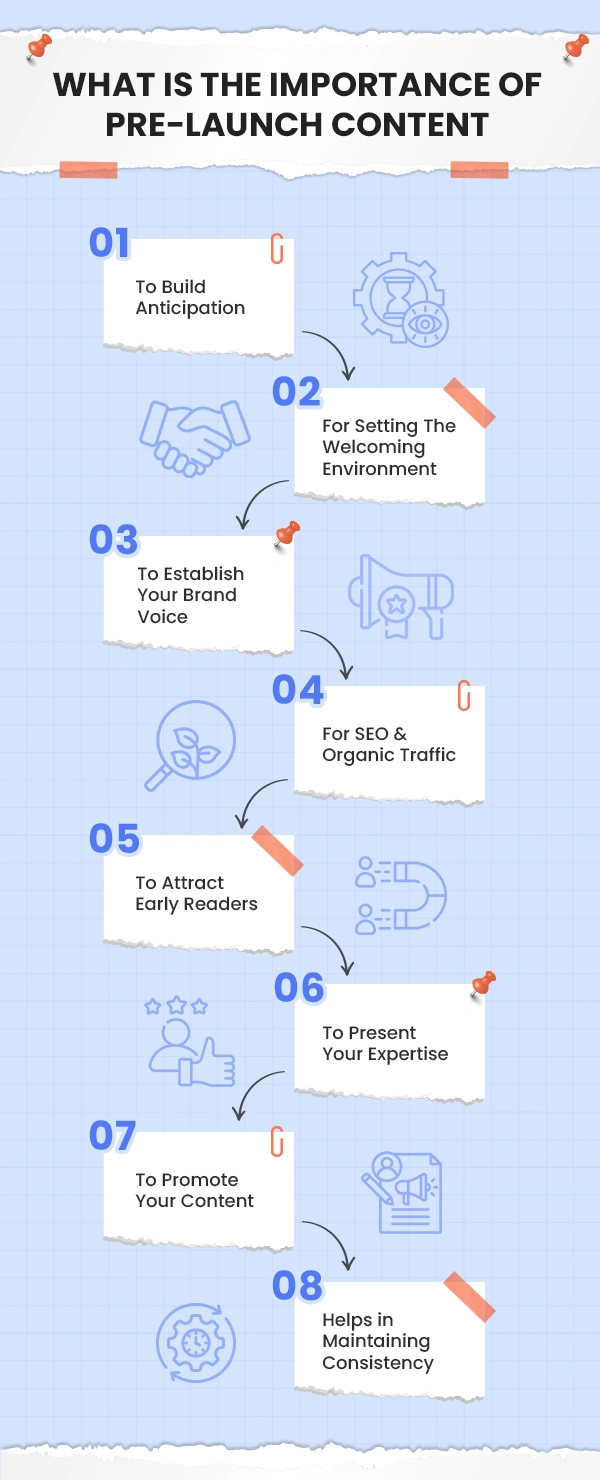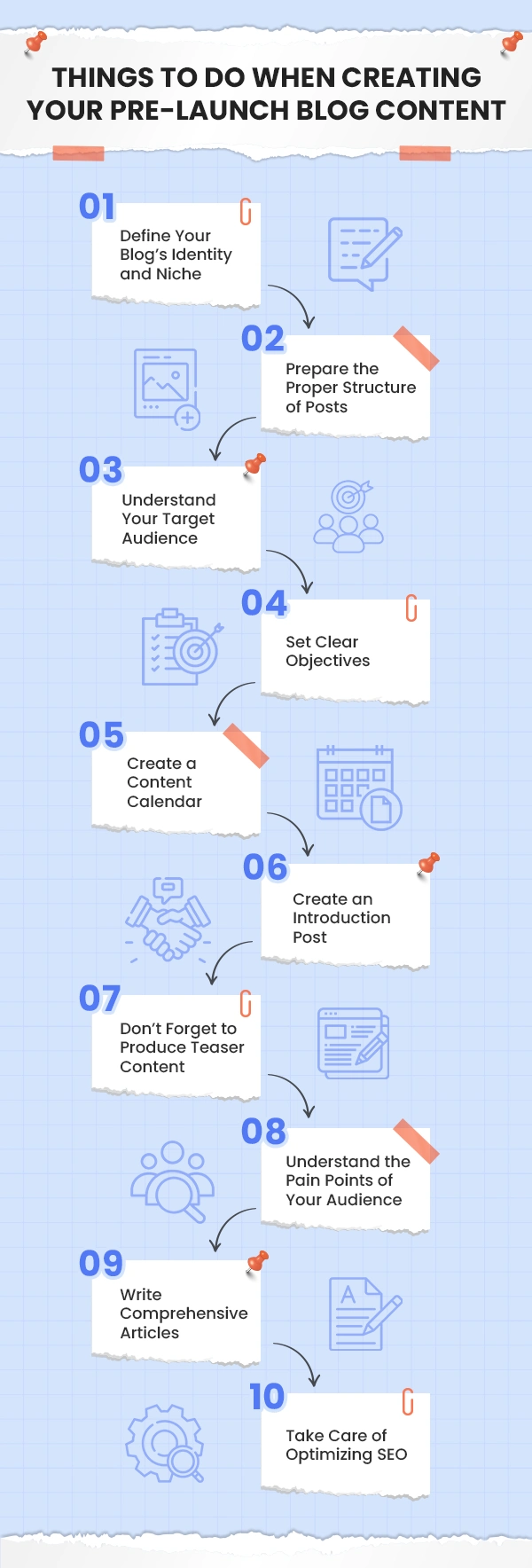| Getting your Trinity Audio player ready... |
What is the ideal number of articles when starting a blog?
It’s a question that every aspiring blogger struggles with. Even experienced bloggers have different opinions when they consider how they first began blogging. The blogging journey is as unique as the individuals who embark on it.
You don’t always need a specific number of articles to start a blog; it all depends on your objectives, market, and personal preferences.
Let us uncover the tactics you can use to build curiosity amongst readers before the final launch.
What do you mean by pre-launch content, you ask?
Any marketing strategy, announcements, or promotional data produced and published by a blogger before launching their blogs is referred to as pre-launch content.
Before the actual launch date, this content is intended to build hype, develop anticipation, and engage the target audience & market. Teaser videos, social media updates, email newsletters, and sneak peeks are just a few examples of pre-launch content.
Pre-launch content is crucial since it can generate enthusiasm and curiosity in potential customers. The following are some major justifications for why pre-launch content is crucial in marketing plans:
Also Read: Is Starting A Blog Worth In 2023?
➔ To Build Anticipation
Pre-launch content acts as a strategic tool to generate buzz, attract audience interest, and create a sense of excitement before the official launch.
You can engage the audience and stir up curiosity by providing sneak peeks, teasers, behind-the-scenes looks, or exclusive previews.
This excitement accomplishes a number of goals, including building a loyal fan following and encouraging a sense of community among potential readers.
A successful launch and long-lasting readership are built on a solid foundation of well-executed pre-launch content, which not only creates excitement but also forges a connection with the audience.
➔ For Setting The Welcoming Environment For Your Blog
Pre-launch content serves as the first handshake with your readers, giving them an idea of the type of content, presentation style, and level of knowledge to expect from your blog.
Pre-launch content that has been meticulously developed can draw attention, spark interest, and help set your site’s tone and style. It arouses interest in potential readers and helps them comprehend the value you want to provide, increasing their propensity to explore your blog further after it is released.
By providing informative and engaging content, you build an inviting environment that encourages readers to interact with one another and join your virtual community.
➔ To Establish Your Brand Voice
By influencing the first impressions of your audience, pre-launch content helps in developing your brand voice. Even before launching your blog, it may be a potent instrument for communicating your brand’s identity and values.
You may establish a distinctive narrative for your brand through pre-launch content, letting readers know what to expect. This first impression creates buzz and enables you to engage personally and emotionally with your target audience, establishing credibility and trust.
By offering a consistent message, style, and tone in your pre-launch content, you can develop a brand identity that resonates with your audience and lays the foundation for a successful readership.
Thus, pre-launch content can be great for both branding & marketing strategies.
➔ For SEO & Organic Traffic
Initially, when a piece of content has been effectively optimized with relevant keywords, it can start pulling in organic traffic even before it is officially released. It allows search engines time to index the pages and understand the context of the website.
Once the site is online, this early indexing may favor its rankings because search engines will see it as a reliable and established source.
Moreover, pre-launch content also enables strategic keyword placement and integration, strengthening the SEO foundation of the website. You may optimize your content for search engine algorithms by finding and implementing effective keywords into the content of your blogs and landing pages.
This foundation ensures that the website is more likely to appear in search results when visitors search for similar keywords after launch, generating organic traffic.
Additionally, pre-launch content offers opportunities for backlink building and social media sharing. High-quality, educational content frequently gets shared and referred to by professionals in the field, raising the site’s authority and search engine ranks.
Pre-launch content serves as a catalyst, laying the groundwork for a strong online presence, increased exposure, and continuous organic traffic in the long run.
Also Read: How Much Does It Cost To Start A Blog In 2023
➔ To Attract Early Readers
Whether it’s a blog or a website, pre-launch content helps build curiosity and attract readers to any platform.
This early engagement creates a sense of community and loyalty that helps creators better understand their audience in order to modify their content to suit the interests and expectations of their audience.
Pre-launch content can also generate excitement on social media and other platforms, drawing in a larger audience and enhancing the possibility that it will go viral.
It sets the stage for a successful launch, creating a foundation of interested readers who are likely to share the content, thereby expanding the reach organically.
Pre-launch content is an effective way to build a loyal and passionate audience from the start and is essential for any creative project’s long-term sustainability and success.
➔ To Present Your Expertise
Pre-launch content helps in showcasing your expertise by strategically crafting content before the launch and establishing yourself as an expert in your field.
This content can come in a variety of formats, including blog articles, videos, podcasts, and social media updates, all of which can be customized to highlight your expertise, insightfulness, and distinct viewpoint.
You can establish credibility and confidence by educating your audience with important information. It creates the foundation for people to see you as a leader, making them more receptive to your blog when it is officially launched.
Pre-launch content also enables you to interact with your audience, identify their requirements, and modify your blogs accordingly, ensuring that your area of expertise properly matches the needs of your target audience.
Pre-launch content gives you an opportunity to highlight your expertise and present a convincing argument for why your audience should pay attention to and invest in what you have to offer.
➔ To Promote Your Content
Pre-launch content sets the foundation for a successful launch by creating a buzz that may increase curiosity and engagement amongst the audience.
Additionally, by delivering helpful content and establishing a sense of authenticity and trust, pre-launch content enables firms to grow and nurture their audience. It enables bloggers to establish a closer relationship with their target audience and learn about their readability preferences prior to the launch.
Moreover, pre-launch content acts as a trial run for bloggers as it establishes a base and allows valuable feedback as well as potential drawbacks that may hamper their launch. It allows them to make necessary changes before its first appearance.
Bloggers can lay a solid foundation for their marketing initiatives, making the launch more effective and successful.
Also Read: What Should You Consider When Developing Website Content?
➔ Helps in Maintaining Consistency
You can create a distinct and unified brand identity by creating and distributing well-planned content prior to the official launch. This consistency is essential as it ensures that the audience will hear a similar message about the blog, its attributes, and its advantages.
With the use of pre-launch content, a company may establish the mood, highlight the brand personality, and emphasize critical content. When these components are utilized consistently throughout all pre-launch content, the audience is left with a powerful and lasting impression. This consistency helps connect customer expectations, improving trust and credibility.
Readers are more likely to know and relate to the blogs when launched, as it promotes more engagement, and they tend to drop positive reviews thanks to the consistent pre-launch content.
Listed above are the reasons why it is important to have pre-launch content. All these factors contribute to why you must strategically plan pre-launch content and how you can build curiosity amongst the audience to boost your blog!
Let’s have a recap of how important pre-launch content is for your blog with an infographic below:

Let us further dive into how many articles are needed in order to launch your blog.
Also Read: How To Organize The Content Of Your Website?
How Many Articles Do I Need to Start a Blog?
After effectively building curiosity with your pre-launch content, it is important to keep things going. Why make your audience wait? Consider creating a solid lineup of 8–10 captivating blogs for the first few days to maintain the enthusiasm.
This offers visitors a substantial amount of content to explore, encouraging them to stay longer on your site and increasing the chances of them becoming regular readers. You can adjust the frequency of your posts depending on your bandwidth and schedule.
However, amidst this enthusiasm, remember the golden rule: quality triumphs over quantity. It is necessary to generate high-quality content.
For instance, if you’re launching a food blog, your first few posts might be a combination of recipes, cooking advice, and food-related tales. You can consider writing about frequently read food articles, such as “Classic Italian Lasagna Recipe” and “Exploring the World of Spices: A Culinary Adventure.”
These articles demonstrate your knowledge and enthusiasm for cuisine and provide your readers with useful information. You may appeal to a wider audience and pull in both amateur chefs and food lovers by providing a diversity of themes.
Genuinely interested readers value information that is insightful and valuable. Delivering relevant content that resonates with your target audience is what it’s all about—not overwhelming your audience with content.
Creating Your Pre-Launch Blog Content
- Define Your Blog’s Identity and Niche
- Prepare the proper structure of Posts
- Understand Your Target Audience
- Set Clear Objectives
- Create a Content Calendar
- Create an Introduction Post
- Don’t Forget to Produce Teaser Content
- Understand the pain points of your audience
- Write Comprehensive Articles
- Take care of optimizing SEO
Our previous discussions explored the significance of a blog’s pre-launch content and the number of articles required during a blog’s launch phase. The pivotal question arises: What should you include in your pre-launch content? Let’s unravel this mystery with some essential pointers to guide you:
➢ Define Your Blog’s Identity and Niche
When developing your pre-launch content, it is essential to establish your blog’s identity and niche. Start by identifying your areas of interest and expertise. What do you enjoy and understand? Your blog should reflect your unique writing style and perspective.
The next step is to specify your niche. Focus on a specialized area where you provide your audience with insightful information or solutions to specific problems rather than discussing broad topics.
Research your target audience’s interests, aligning your content with their needs. This focus helps establish authority in your niche and attracts a specific audience.
Consistency in your content, tone, and subject matter will strengthen your blog’s identity, making it distinctive and appealing to your readers. Remember, authenticity is key – let your passion and expertise shine through every post to create a compelling pre-launch content strategy for your blog.
➢ Prepare the proper structure of Posts
Adhering to a structured methodology is essential to engage your audience when developing pre-launch blog content effectively. Firstly, establish the goal of your blog and your target audience.
Then, create eye-catching headlines and introductions that hook readers from the start. Provide valuable and informative content relevant to your niche in the body of your piece, ensuring it is well-researched and reliable. Use pictures, bullet points, and subheadings to break up the text and make it easier to read.
For search engine optimization (SEO), organically include relevant keywords. Encourage reader participation by asking questions or inserting calls to action, such as requesting them to subscribe for updates or offer their ideas in the comments section.
Lastly, always proofread your content for grammar and spelling errors before publishing to maintain a professional image. Pre-launch blog posts can help you establish a strong online presence & build interest in your upcoming blog by effectively structuring them.
Also Read: What Pages Should A Blog Have?
➢ Understand Your Target Audience
Understanding your target audience is essential when it comes to creating pre-launch blog content. You can get started by conducting in-depth research to determine your audience’s characteristics, passions, and preferences.
Use surveys, social media analytics, and keyword research to acquire insightful data. Adapt your blog’s content to address your audience’s unique requirements, difficulties, and interests after you have a firm grasp of who they are.
To effectively engage people, tell captivating stories, offer insightful information, and take care of their problem areas. Make use of a tone and style that resonate with your audience, ensuring your content feels relatable and authentic.
By empathizing with your audience and addressing their concerns, you can create blog content that not only captures their attention but also establishes a strong connection, increasing the chances of a successful pre-launch phase for your blog.
➢ Set Clear Objectives
A successful blog launch depends on setting clear goals while generating pre-launch blog content. Begin by defining the purpose of your blog, identifying your target audience, and understanding their needs and interests.
Establish simple, measurable, and realistic goals for your content, such as boosting website traffic, improving brand recognition, or generating potential customers. Consider the issues that appeal to your audience and the tone and style that complements your brand’s identity.
To guarantee consistency, create a content schedule with due dates. Additionally, you can stay consistent after successfully launching the blogs and establishing a base for your readers by evaluating your performance and changing its approach to accomplish these objectives.
Using this methodological technique, you can develop targeted and purposeful pre-launch blog content that promotes the desired results.
Also Read: How Can You Make A Website Look More Professional?
➢ Create a Content Calendar
A pre-launch content calendar is crucial for planning your ideas and ensuring a steady stream of interesting content in the months before launch. You can list the main themes and subjects associated with your blog niche. Mark important dates, occasions, or events hosted by already-established bloggers related to your content, as it may help you gain some insights.
Plan out your posts, taking into account how frequently you want to add new content. Depending on your resources and the demands of your audience, you may post once a day or once a week.
Additionally, mix up the genres of your work. To appeal to various audience tastes, incorporate blog articles, videos, infographics, podcasts, and social media updates. By adding diversity, you can reach a wider audience while maintaining the quality of your content.
Lastly, your content calendar should be flexible to adapt and make necessary changes when required. Be prepared to adjust to new concepts and trends so your content can change in response to the constantly changing interests of the target audiences. Staying ahead in the blogging world will continue to rely on drawing inspiration from fellow industry bloggers and adapting to emerging trends.
Bloggers may guarantee the expansion and exposure of their platforms by embracing creative techniques and keeping up with the most recent trends. Maintaining a competitive edge will depend on your ability to adapt and incorporate new ideas as search algorithms change and consumer tastes fluctuate.
The key to a successful blogging journey in the future will be connecting with the blogging community, learning from peers, and staying adaptable regardless of technological changes.
➢ Create an Introduction Post
When creating your pre-launch content, try to grab the interest of your readers and create anticipation for what your blog has to give. You can address the core issue or theme your blog will focus on, emphasizing its importance and relevance.
Give readers a taste of what’s to come in upcoming posts as you wrap up the introduction. Use conversational language, be concise but informative, and promote engagement by soliciting reader comments and input. By doing this, you can establish the tone for your blog and raise interest in your next posts.
Producing teaser content is an excellent approach to building curiosity and anticipation amongst the readers when developing pre-launch blog content. Teaser content is composed of brief yet captivating excerpts that hint at the theme of your blog without giving everything away.
This could take the shape of captivating quotes, eye-catching images, or brief descriptions of the topics you’ll discuss. Teasers must grab readers’ curiosity and make them desire to know more. They might refer to the issues you’ll resolve, the insightful data you’ll supply, or the distinctive viewpoint you’ll present.
Also Read: Best Content Management System Platform Optimized For SEO
➢ Understand the pain points of your audience
When generating pre-launch blog content, it is essential to understand the problems that your audience is experiencing. To do this effectively, you need to put yourself in your readers’ shoes and resonate with them.
To understand the issues, worries, and problems your target audience faces, conduct extensive market research, engage with them, and learn more about their concerns by actively paying attention.
Once you understand their concerns, you can modify your pre-launch blog posts to address these problems specifically. Create captivating narratives, understandable examples, and useful answers that speak to your audience’s problems.
You establish trust and credibility by addressing their pain points authentically, creating a loyal readership base eagerly anticipating your blog’s launch.
➢ Write Comprehensive Articles
Setting the tone and creating in-depth articles that draw in your blog’s audience is crucial when writing pre-launch content. Conduct thorough research on your chosen topic to ensure you have a deep understanding of it.
Create a layout by outlining your thoughts and structuring your article logically. Start with a great introduction to capture readers’ attention and clarify your article’s aim.
Provide detailed and well-researched information, breaking down complex concepts into easily digestible sections in the body. Use clear and concise language to increase credibility by supporting your points with relevant examples, statistics, and expert quotes.
Don’t forget to break up the text with interesting visuals like photos, infographics, or videos to make your content more visually appealing. To boost readability, ensure your post is properly formatted with subheadings, bullet points, and numbered lists.
Create a call to action at the end of your article to encourage readers to interact with your blog further by subscribing for updates or sharing the piece on social media. Last but not least, to project a polished and professional picture to your audience, always check your post for grammatical mistakes and coherence before publishing.
➢ Take care of optimizing SEO
While creating pre-launch content, SEO optimization is crucial for boosting organic traffic to your website. Carrying out keyword research to find highly relevant and popular search terms associated with your blog’s subject. Include these keywords naturally throughout your blog entries, in the titles, headers, and body copy.
Concentrate on producing informative, interesting, high-quality content that benefits your audience. To enhance click-through rates from search engine results pages, use appealing meta titles and meta descriptions that include your target keywords. For the best user experience, ensure your website is responsive to mobile devices and has a simple, user-friendly design.
Additionally, strategically interlink your blog content to boost site navigation and general SEO structure. Use social media sites to promote your pre-launch content, increasing its exposure and the chance for backlinks, which helps your SEO efforts. By keeping an eye on these elements, you’ll build a solid SEO foundation for your blog even before it goes live.
Let’s have a recap of how you can create your pre-launch blog content with an infographic below:

Also Read: Does SSL Help SEO? Discover Eye-Opening Insights
FAQs
Depending on the scale and complexity of your project, start your pre-launch content a few months before your launch date. It allows you to build anticipation and engage your audience, giving you time to plan, create, and refine your content. Early planning also enables you to leverage various marketing channels, maximizing your reach and ensuring alignment with your goals.
Yes, 300 words can be sufficient for a blog post, depending on the topic and the depth of information you want to convey. Short-form content like this is excellent for brief updates, personal anecdotes, or concise explanations of straightforward concepts. It can also work well for listicles, quick tips, or summaries of recent events.
However, it may not provide enough space for in-depth analysis or complex topics, which might require a longer word count to explore and provide valuable insights fully.
When writing a 300-word blog post, it’s crucial to be clear, concise and focused on your main points. Engaging readers from the beginning and delivering your message is key to making the most impact within this limited word count.
With a staggering 4.8 billion users worldwide, social media has become an omnipresent force, shaping the way individuals connect, share, and engage in the digital era. Utilizing social media content involves identifying your target audience and the social media platforms they frequent. Develop visually appealing and engaging content related to your pre-launch, including teasers, behind-the-scenes glimpses, and countdowns.
Use relevant hashtags to increase visibility and collaborate with influencers or bloggers who align with your content. Encourage audience interaction through polls, contests, or Q&A sessions.
After the blog launch, a content plan is essential as it provides a roadmap for consistent and relevant posts, which is crucial for engagement and building a loyal readership.
Moreover, having a plan lets you stay organized, covering various topics, maintaining a consistent posting schedule, and effectively managing your time and resources. Overall, a well-thought-out content plan significantly contributes to the success and sustainability of your blog.
Conclusion
The ideal number of articles to start a blog varies based on personal preferences, objectives, and the target audience. While there’s no specific number required, having a few high-quality posts before launching the blog is advisable.
Pre-launch content plays a crucial role in raising awareness, engaging the audience, and establishing a brand identity. It includes teasers, behind-the-scenes looks, and exclusive previews, creating buzz and excitement before the official launch.
Pre-launch content also aids in SEO optimization, attracting early readers, showcasing expertise, promoting content, ensuring consistency, and addressing audience pain points.
A well-structured pre-launch content strategy involves defining your blog’s identity and niche, understanding your target audience, setting clear objectives, creating a content calendar, producing introduction and teaser posts, writing comprehensive articles, and optimizing SEO.




